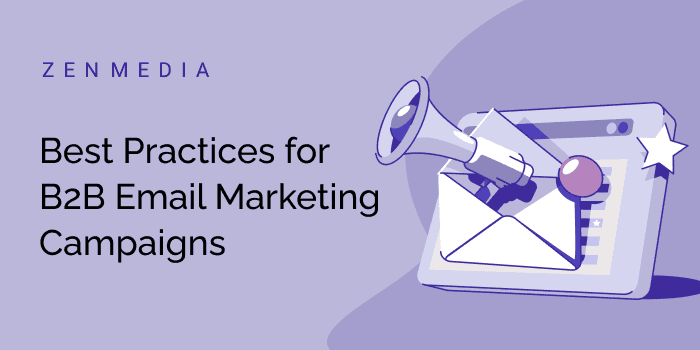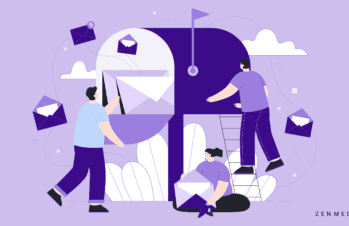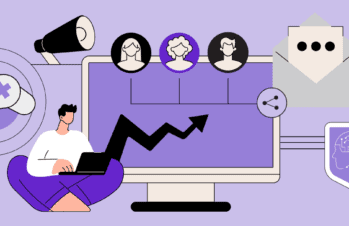As every B2B marketing agency adapts to accommodate innovations in AI and ML, email marketing remains a cornerstone of effective B2B communication strategies. For businesses seeking expertise in this area, partnering with a specialized B2B email marketing agency can be particularly crucial. Email allows businesses to directly reach decision-makers in their inboxes, making it a powerful tool for nurturing leads, building relationships, and driving conversions. With 50% of B2B marketers citing email as the most valuable channel in a multichannel strategy, it’s clear that mastering email campaigns is invaluable for success in the B2B space.
Currently, email marketing is characterized by increasing personalization, automation, and a focus on delivering value to recipients. As inbox competition intensifies, businesses must adopt sophisticated strategies to stand out and engage their audience effectively.
Let’s explore the 9 best practices for creating successful B2B email campaigns that drive results and solidify long-term customer relationships.
Related Reading: 51 Incredible Examples of B2B Email Marketing
Understanding Your Audience
As veterans of any B2B digital marketing agency will tell you, the heart of any successful email marketing campaign is a deep understanding of your audience. Audience segmentation is key to delivering relevant, personalized content that resonates with your recipients. By dividing your email list into smaller groups based on specific criteria such as industry, company size, or job role, you can tailor your messaging to address each segment’s unique needs and pain points.
Leveraging data for personalization goes beyond simply using a recipient’s first name in the subject line. It involves analyzing behavioral data, purchase history, and engagement patterns to create highly targeted campaigns. For example, a software company might send different email content to C-level executives than IT managers, addressing their specific concerns and decision-making factors.
Creating detailed buyer personas is another crucial step in understanding your audience. These fictional representations of your ideal customers help guide content creation and ensure your emails speak directly to the needs and motivations of your target audience. When developing buyer personas, consider factors, such as job responsibilities, challenges, goals, and preferred communication channels.
Related Reading: The Importance of Connecting With Your Audience in B2B Marketing
Crafting Compelling Content
The content of your email is what will ultimately determine its success. Creating value-driven, narrative content should be at the forefront of your email marketing strategy. Your emails should provide tangible benefits to the reader, whether through industry insights, practical tips, or solutions to common challenges.
Balancing educational and promotional material is crucial in B2B email marketing. While the ultimate goal is to drive conversions, bombarding recipients with sales pitches will likely lead to disengagement. Instead, aim for a ratio of 80/20—80% educational to 20% promotional content. This approach positions your brand as a trusted advisor and thought leader in your industry.
Related Reading: How to Write Incredibly Successful B2B Marketing Content
Incorporating user-generated content (UGC) can significantly boost the authenticity and relatability of your emails. Customer testimonials, case studies, and success stories provide social proof and help potential clients envision how your product or service can benefit their business. UGC is particularly effective in B2B contexts, where decision-makers often rely on peer recommendations and real-world examples.
To enhance engagement, consider using video, images, and other interactive elements in your emails. In fact, 31% of marketers say short-form video content offers the highest ROI. Whether it’s a product demo, a behind-the-scenes look at your company, or an expert interview, video can convey complex information in an easily digestible format.
Optimizing Email Design
The design of your email plays a crucial role in how your message is received and acted upon. In today’s mobile-first world, prioritizing a responsive design that looks great on all devices is non-negotiable. With 55% of emails opened on mobile devices, ensuring your emails are easily readable and navigable on smaller screens is essential.
Related Reading: One Thing You Can Change Today to Improve Your Website’s User Experience: Optimize Mobile Site Speed
Incorporating minimalist design trends can help your emails stand out in cluttered inboxes. Clean layouts, ample white space, and clear hierarchies guide the reader’s attention to key messages and calls-to-action (CTAs). This approach not only improves the visual appeal of your emails but also enhances readability and comprehension.
Accessibility should be a key consideration in email design, too. Use clear, legible fonts and ensure sufficient color contrast. Include alt text for images to accommodate visually impaired recipients using screen readers. By making your emails accessible to all, you expand your reach and demonstrate your commitment to inclusivity.
Effective use of visuals and CTAs can significantly impact the performance of your emails. Use high-quality images that add value to your content rather than generic stock photos. Place clear, compelling CTAs strategically throughout your email, using action-oriented language and contrasting colors to make them stand out.
Personalization and AI Integration
Hyper-personalization is becoming increasingly important in B2B email marketing. This goes beyond basic personalization techniques to create highly tailored experiences for each recipient. By leveraging data from multiple touchpoints, you can create emails that speak directly to a recipient’s specific needs, interests, and stage in the buyer’s journey.
AI-driven predictive analytics is revolutionizing email marketing by allowing businesses to anticipate customer needs and behaviors. These sophisticated algorithms can analyze vast amounts of data to predict the best time to send emails, the most effective subject lines, and even the content most likely to resonate with each recipient.
Automated personalized content creation is another area where AI is making significant strides. AI tools can generate customized email content at scale, ensuring each recipient receives relevant information without requiring manual intervention for every send. This technology enables businesses to maintain a high level of personalization even as their email lists grow.
Related Reading: The Pros and Cons of AI in Marketing
Building and Maintaining Email Lists
Ethical list-building strategies are crucial for long-term success in email marketing. Focus on organic growth through opt-in forms on your website, gated content, and events. Avoid purchasing email lists, as these often lead to poor engagement rates and can damage your sender reputation.
Regularly maintaining and cleaning up your email lists is essential for maintaining high deliverability rates and engagement. Remove inactive subscribers, update changed email addresses, and segment your list based on engagement levels. This practice ensures your emails reach interested recipients and improves overall campaign performance.
Re-engagement campaigns can be an effective way to win back inactive subscribers before removing them from your list. These campaigns might offer exclusive content and discounts or simply ask if the recipient still wants to hear from you. By giving inactive subscribers a chance to re-engage, you can potentially recover valuable contacts while maintaining a clean, responsive email list.
Timing and Frequency
Finding the optimal time to send B2B emails can significantly impact open and click-through rates. While the best time can vary depending on your specific audience, research suggests that 9 a.m.-3 p.m. EST is generally an optimal window to send marketing emails. However, it’s crucial to test different send times with your audience to determine what works best for your specific subscribers.
Determining the right email frequency is a balancing act. Send too few emails, and you risk being forgotten; send too many, and you may annoy your subscribers. The optimal frequency can vary depending on your industry and the nature of your content, but a good starting point is 1-2 emails per week for B2B communications.
Automated drip campaigns can help you maintain consistent communication with your subscribers without overwhelming them. These pre-planned sequences of emails are triggered by specific actions or time intervals, allowing you to nurture leads and guide them through the buyer’s journey automatically.
Compliance and Security
Ensuring compliance with regulations such as GDPR, CCPA, and other data protection laws is non-negotiable in email marketing. For example, California recently passed a new law allowing consumers to opt out of subscriptions with just one click. These regulations govern how businesses collect, store, and use personal data. Implement clear opt-in processes, provide easy unsubscribe options, and maintain transparent data practices to stay compliant.
Data privacy best practices go beyond legal compliance to build trust with your subscribers. Be clear about how you collect and use data, limit the amount of personal information you request, and provide options for subscribers to control their data preferences. Regularly review and update your privacy policies to reflect any changes in your data handling practices.
Implementing secure sending practices is crucial for protecting both your business and your subscribers. Use encryption for sensitive information, regularly update your email marketing software to patch security vulnerabilities, and educate your team about phishing and other email-related security threats.
Integration with Other Marketing Channels
Aligning your email marketing with your broader content marketing strategy ensures consistency in messaging and maximizes the impact of your marketing efforts. Use your emails to promote your latest blog posts, whitepapers, or webinars, creating a cohesive customer experience across all touchpoints.
Related Reading: Digital Marketing Tips for B2Bs
Social media integration can amplify the reach of your email campaigns. Include social sharing buttons in your emails to encourage recipients to spread your content on their networks. Conversely, use social media to grow your email list by promoting gated content or exclusive email offers to your followers.
Syncing your email marketing efforts with your CRM and marketing automation platforms allows for more sophisticated, data-driven campaigns. This integration enables you to track customer interactions across multiple channels, trigger automated email sequences based on specific actions, and provide your sales team with valuable insights for follow-up.
Testing and Optimization
A/B testing is a powerful tool for continually improving your email marketing performance. Test different elements such as subject lines, email copy, CTAs, and send times to identify what resonates best with your audience. Remember to test one element at a time to clearly understand what’s driving any changes in performance.
Key metrics to track include open rates, click-through rates, conversion rates, and unsubscribe rates. These metrics provide insights into how well your emails are performing and where there might be room for improvement. Set benchmarks based on industry standards and your own historical data, and continuously work to improve these metrics.
Implement a continuous improvement process by regularly analyzing your email performance data, identifying areas for improvement, and implementing changes based on your findings. This iterative approach ensures your email marketing strategy remains effective and continues to drive results over time.
Hit Send!
Mastering B2B email marketing requires a strategic approach that combines audience understanding, compelling content creation, optimized design, and data-driven decision-making. By implementing these best practices, businesses can create email campaigns that not only reach their target audience but also engage, nurture, and convert them into loyal customers.
As email marketing continues to evolve, staying ahead of trends such as increased personalization, AI integration, and interactive content will be crucial for maintaining a competitive edge. By continuously refining your approach and adapting to new technologies and consumer preferences, you can ensure your B2B email marketing campaigns remain effective and drive long-term business success.
Ready to take your B2B email marketing to the next level? Reach out! As a cutting-edge B2B marketing agency, our team can help you implement these best practices and develop a tailored email marketing strategy that aligns with your business goals and drives measurable results.





